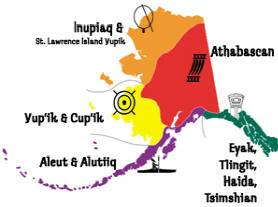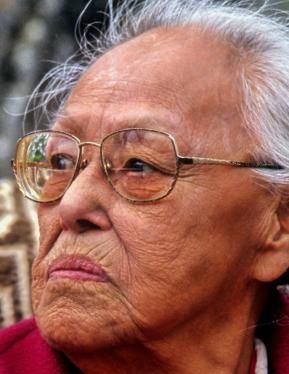|
Alaska Natives are the indigenous peoples of Alaska. They include: Aleut, Inuit, Tlingit, Haida, Tsimshian, Eyak, and a number of Northern Athabasca cultures. Alaskan natives in Alaska number about 119,241 (as of the 2000 census). There are 229 federally recognized Alaskan villages and five unrecognized Tlingit Alaskan Indian tribes.
The Eyak Indians are the smallest native group in Alaska. Their traditional village on the Copper River highway on the Malaspina Coastal Plain was absorbed into the town of Cordova, Alaska in 1906, when their numbers had dwindled to only about 60 Eyak remaining.
In January of 2008, The last full-blooded member of Alaska’s Eyak Indians died at the age of 89. She was the only known full blooded Eyak who could speak the traditional Eyak language fluently. Eyak is a nearly extinct Na-Dené language that is a sub-branch to the Athabascan language in the Athabascan-Eyak-Tlingit language family. Marie Smith Jones was the last remaining fluent speaker of the tribe’s native Alaskan language. Following the death of the last of her siblings in the 1990s, Jones worked to preserve the Eyak’s heritage, helping to compile a dictionary of their language so it might be resurrected by future generations. Jones was born in Cordova in 1918 and grew up on Eyak Lake, where her family had a homestead. Many of her siblings died young when smallpox and influenza tore through the Eyak population.
The Eyak had an exogamous (meaning they married outside of their own group), matrilineal clan system, which means that the children trace their lineage and names from their mother and also inherited the use of the clan fishing, hunting and gathering land from the mother. The Eyak clan system is divided into two moieties, the Raven and the Eagle. Traditionally, clans owned the salmon streams, halibut banks, berry patches, land for hunting, intertidal regions, and egg harvesting areas. As long as the area was used by the clan, they owned the area. The food was seasonal and therefore had to be preserved for the winter months and for early spring. The food was preserved by smoking in smokehouses or was dried, either by wind or sun. These subsistence patterns are still a crucial part of Southeast Alaska Native people’s cultural identity.
The Eyak initially moved out of the interior down the Copper River to the coast. There they harvested the rich salmon fishing grounds. When the Russians arrived they recognized the Eyak as a distinct culture and described their territory on their maps. They also traded with the Eyak and sent them missionaries. Because of their small population they were often raided and their territory boundaries were under pressure from the Chugach to the west.
The Tlingit, on the east side, had better relations with the Eyak and this led to intermarriage and assimilation of many Eyak. This pushed the Eyak's territorial boundary further west and contributed to the Eyak's decline. When the Americans arrived they started canneries and competed with the Eyak for salmon. This combined with integration with, and novel diseases introduced by non-native settlers led to the further decline of the Eyak. As populations decreased the remaining Eyak began to congregate near the village of Orca.
Eyak Shamans used drums or painted wooden figures of humans, mammals, and other critters that were made powerful when in the shamans’ possession. These objects were used to heal, foretell the future, prevent evil spirits, grant fertility, and/or travel into the spirit realm.
The Eyak were organized into two moieties, meaning their clan system is divided into two reciprocating halves or “one of two equal parts”. Their moieties, Raven and the Eagle, equated with the Tlingit Raven and Eagle/Wolf and with the Ahtna Crow and Sea Gull moieties. The names and stories of the clans in these moieties show relationships with the Tlingit and Ahtna.
The Eyak adapted some of the customs of their Alutiiq Eskimo neighbors, and others from the Tlingit. They hunted seal and sea otter. These were only a minor part of their diet; salmon was their chief food. They fished for halibut with hook and line from canoes. They collected clams from the beaches. They netted eulachon from the Copper River between February and April. In the fall they hunted ducks, geese, and swan. Grouse and ptarmigan were hunted year around. Dogs aided in hunting for brown and black bear. Beaver, fox, lynx, marten, muskrat, and weasel were taken with deadfalls and snares.
|




